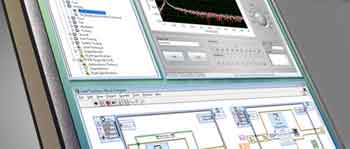National Instruments LabVIEW 8.5 is the latest version of the company's popular graphical system design platform for test, control and embedded system development.
With the adoption of next-generation processors, engineers and scientists must consider how their software can deliver the potential performance gains of multicore and FPGA-based systems. With the parallel dataflow language of LabVIEW, users can map their applications to multicore and FPGA architectures for data streaming, control, analysis and signal processing.
Building on the automatic multithreading capability of earlier versions, LabVIEW 8.5 scales user applications based on the total available number of cores and delivers thread-safe drivers and libraries to improve throughput for RF, high-speed digital I/O and mixed-signal test applications.
LabVIEW 8.5 also delivers symmetric multiprocessing (SMP) with the LabVIEW Real-Time environment where designers of embedded and industrial systems automatically can load balance tasks across multiple cores without sacrificing determinism.
With the latest version, users can also manually assign portions of code to specific processor cores to fine-tune real-time systems or isolate time-critical sections of code on a dedicated core. To meet the more challenging debugging and code optimisation requirements of real-time multicore development, engineers tists can use the new NI Real-Time Execution Trace Toolkit 2.0 to visually display timing relationships between sections of their code and the individual threads and processing cores where the code is executing.
The inherent parallelism of LabVIEW also makes it suitable for developing FPGA applications. LabVIEW 8.5 continues to simplify the task of programming FPGAs with an enhanced FPGA Project Wizard that automates I/O configuration, IP development and overall setup for common I/O, counter/timer and encoder applications. Using the FPGA Project Wizard, engineers and scientists can automate the generation of more complex high-speed DMA data transfer code.
Additionally, the new release offers multichannel filtering and PID control functions commonly needed in machine automation to significantly reduce FPGA resources for high-channel-count applications. It also extends the LabVIEW platform further into embedded and industrial applications with a new statechart design module for modelling and implementing system behaviour as well as new I/O libraries and analysis functions for industrial monitoring and control.

Statecharts are commonly used to design state machines to model the behaviour of real-time and embedded systems to depict event occurrences and responses for digital communication protocols, machine controllers and system-protection applications. LabVIEW 8.5's new statechart module can help engineers and scientists design and simulate these event-based systems using familiar, high-level statechart notations based on the Unified Modeling Language (UML) standard.
Because the Statechart Module is based on the LabVIEW graphical programming language, engineers have a single platform to design, prototype and deploy their systems, combining familiar statechart notation with real-world I/O running on deterministic real-time or FPGA-based systems.
The new release adds a wide array of I/O, measurement and display enhancements for those building PAC-based industrial systems, including a new library of OPC drivers for programmable logic controllers (PLCs) and other industrial devices.
LabVIEW 8.5 also has new vibration and order tracking measurements and machine vision algorithms for industrial machine monitoring systems. For high-channel-count systems, a new multivariable editor allows users to configure or edit hundreds of I/O tags using a simple spreadsheet interface.
Lastly, the software sports flexible pipe display tools to simplify the process for building more realistic industrial user interfaces and an interactive drag-and-drop approach to tie I/O tags directly to user interface displays running on Windows CE-based industrial touch panels and handheld PDAs.




Glasgow trial explores AR cues for autonomous road safety
They've ploughed into a few vulnerable road users in the past. Making that less likely will make it spectacularly easy to stop the traffic for...